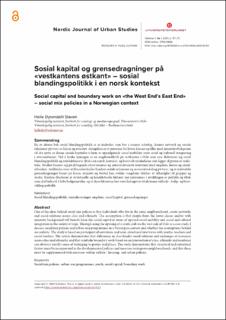| dc.contributor.author | Staven, Helle Dyrendahl | |
| dc.coverage.spatial | Norge, Oslo | en_US |
| dc.date.accessioned | 2021-10-06T08:58:21Z | |
| dc.date.available | 2021-10-06T08:58:21Z | |
| dc.date.created | 2021-09-06T13:16:28Z | |
| dc.date.issued | 2021-06-30 | |
| dc.identifier.citation | Nordic Journal of Urban Studies. 2021, 1 (1), 57-73. | en_US |
| dc.identifier.issn | 2703-8866 | |
| dc.identifier.uri | https://hdl.handle.net/11250/2788032 | |
| dc.description.abstract | En av ideene bak sosial blandingspolitikk er at individer som bor i samme nabolag, danner nettverk og sosiale relasjoner på tvers av klasse og etnisitet. Antagelsen er at personer fra lavere klasser og/eller med minoritetsbakgrunn vil dra nytte av denne sosiale kapitalen i form av oppadgående sosial mobilitet samt sosial og kulturell integrering i storsamfunnet. Ved å bruke åpningen av en ungdomsklubb på vestkanten i Oslo som case diskuterer jeg sosial blandingspolitikk og områdebaserte tiltak i en norsk kontekst, og hvorvidt antakelsene som ligger til grunn er realistiske. Studien baserer seg på deltagende observasjoner og semistrukturerte intervjuer med ungdom, lærere og sosialarbeidere. Artikkelen viser at klasseforskjeller hindrer sosiale relasjoner og ressursutveksling på tvers, og at symbolske grensedragninger basert på klasse, etnisitet og bosted kan svekke «ungdoms følelse» av tilhørighet til grupper og steder. Studien illustrerer at strukturelle og kontekstuelle faktorer må innlemmes i utviklingen av politikk og tiltak som skal bidra til å løfte boligområder, og at disse faktorene bør være ledsaget av tiltak innen velferds-, bolig- og byutviklingspolitikk. | en_US |
| dc.description.abstract | One of the ideas behind social mix policies is that individuals who live in the same neighbourhood, create networks and social relations across class and ethnicity. The assumption is that people from the lower classes and/or with minority background will benefit from this social capital in terms of upward social mobility and social and cultural integration in the society at large. Through using the opening of a youth club on the west side of Oslo as a case study, I discuss social mix policies and urban area programmes in a Norwegian context and whether the assumptions behind are realistic. The study is based on participant observations and semi-structured interviews with youths, teachers and social workers. The article demonstrates that differences in class hinder social relations and exchanges of resources across class and ethnicity, and that symbolic boundary work based on an intersection of class, ethnicity and residency can obstruct youth’s sense of belonging to groups and places. The study demonstrates that structural and contextual factors must be incorporated in the development of policies and measures to improve neighbourhoods, and that these must be supplemented with measures within welfare-, housing- and urban policies. | en_US |
| dc.language.iso | nob | en_US |
| dc.publisher | Universitetsforlaget | en_US |
| dc.relation.ispartofseries | Nordic Journal of Urban Studies;Volume 1, No. 1-2021 | |
| dc.rights | Navngivelse-Ikkekommersiell 4.0 Internasjonal | * |
| dc.rights.uri | http://creativecommons.org/licenses/by-nc/4.0/deed.no | * |
| dc.subject | Sosial blandingspolitikk | en_US |
| dc.subject | Områdesatsinger | en_US |
| dc.subject | Områdesatsinger | en_US |
| dc.subject | Ungdom | en_US |
| dc.subject | Sosial kapital | en_US |
| dc.subject | Grensedragninger | en_US |
| dc.subject | Social mix policies | en_US |
| dc.subject | Urban area programmes | en_US |
| dc.subject | Youth | en_US |
| dc.subject | Social capital | en_US |
| dc.subject | Boundary work | en_US |
| dc.title | Sosial kapital og grensedragninger på «vestkantens østkant» – sosial blandingspolitikk i en norsk kontekst | en_US |
| dc.title.alternative | Social capital and boundary work on «the West End’s East End» – social mix policies in a Norwegian context | en_US |
| dc.type | Peer reviewed | en_US |
| dc.type | Journal article | en_US |
| dc.description.version | publishedVersion | en_US |
| dc.rights.holder | © 2021 Author(s) | en_US |
| cristin.ispublished | true | |
| cristin.fulltext | original | |
| dc.identifier.doi | https://doi.org/10.18261/issn.2703-8866-2021-01-04 | |
| dc.identifier.cristin | 1931627 | |
| dc.source.journal | Nordic Journal of Urban Studies | en_US |
| dc.source.volume | 1 | en_US |
| dc.source.issue | 1 | en_US |
| dc.source.pagenumber | 57-73 | en_US |

